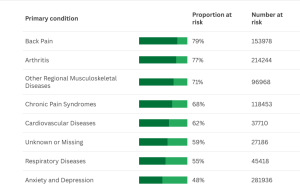Disability cuts most likely to fall on people in areas of deprivation

A correlation between deprivation and the likelihood of having your disability benefits cut has been found by economists and think tanks advising against planned welfare reforms.
Under changes to Personal Independence Payments (PIP) coming into effect in November 2026, applicants must score at least four points in one area to qualify for the daily living component.
A heat map based on an analysis of Department for Work and Pensions (DWP) administrative data and published at Medium shows those most at risk of cuts are clustered in areas of deprivation like south Wales, the northeast and northwest of England, and the West Midlands.

Ayaz Manji, a policy manager at the Trussell Trust said on X: "The reason more people receive benefits like PIP isn't because these benefits have got any easier to claim - in fact the proportion of successful claims has stayed stable.
"The biggest drivers of the increase in claims are rates of disability and increasing numbers of disabled people in poverty.”
Following the Spring statement, the Office for Budget Responsibility predicted that 800,000 or more people look set to lose the daily living component of PIP with average losses of around £4,500 a year.
The figure could, in fact, be higher. The OBR takes into account what it terms 'behaviour changes' on the part of both claimants and assessors following the reforms, with claimants fighting harder to be awarded, and assessors potentially being more lenient. But these predictions may not be borne out.
The cuts, which aimed to save the Treasury £5 billion, have been met with a widespread outcry and there are rumours of a U-turn amid threats of mass rebellion by 170 Labour MPs.
Contrary to claims of overdiagnosis, fraud, and leniency in the system, poverty is considered to have been the major driver in the increase in number of PIP claims over recent years.
Max Mosley, senior economist at the left-leaning New Economic Foundation (NEF) think tank, said: “We found that on its own, the number of disabled people explains 71 per cent of the PIP caseload in a particular region.
“But when we add each region’s relative deprivation using the Index of Multiple Deprivation (IMD) we can explain 94 per cent of the regional PIP caseload.
“On this basis, it seems unlikely that the proposed tightening of eligibility for PIP will achieve much other than causing further hardship for a group struggling the most since the pandemic.”
In a separate Freedom of Information investigation, the campaign and advisory group Benefits and Work uncovered which medical conditions hold the highest risk of losing PIP.

The top five conditions proportionally more likely to mean a cut to PIP in forthcoming changes to eligibility are:
- Back pain (79 per cent of claimants have no four-point score in a single category)
- Arthritis (77 per cent)
- Other musculoskeletal disease (71 per cent)
- Chronic pain syndromes (68 per cent)
- Cardiovascular disease (62 per cent).
One in three people with cancer is at risk of losing PIP, along with around half of those with respiratory disease. This contradicts claims in media coverage that the cuts are aimed at claimants who typically have 'lower needs'.
A spokesperson for Benefits and Work said: "Labour's PIP cuts are overwhelmingly aimed at older, but still working age, claimants with physical health conditions, many of whom will have been employed for most of their adult life and many of whom will still be employed.
“Almost half (46 per cent) of all working age PIP claimants are at risk of losing their award on review from November 2026.”
Disability campaigners are continuing to lobby for a reversal to the proposed PIP reforms - a mass protest at Westminster took place on 22 May. Up to 40 MPs say they have held consultations with disabled constituents.
There are rumours of a “watering down” of the benefit cuts, with frontbenchers increasingly threatening resignations otherwise.
The Pathways to Work consultation, which includes the proposed PIP cuts, runs until June 30.
DWP response
A Department for Work and Pensions (DWP) spokesperson pointed to the fact that claimants may score four points on reassessment, and that people with the most severe life-long conditions will be exempt from reassessment.
The spokesperson also flagged up the current consultation on the Pathways to Work green paper, plans for a wider review, and Get Britain Working reforms, adding in relation to criticisms by campaigners: “This data is partial and doesn’t reflect that the majority of people who are currently getting PIP will continue to receive it.
“We will never compromise on protecting people who need our support, and our reforms will mean the social security system will always be there for those who will never be able to work, and that their income is protected.
“We have also announced a review of the PIP assessment, and we will be working with disabled people and key organisations representing them to consider how best to do this as we deliver on our Plan for Change."
The government has announced it will be increasing the main rate of Universal Credit, above inflation, and will provide £1 billion additional funding for employment support for disabled people.
In a ministerial foreword to the consultation, Liz Kendall states: "Too many disabled people and people with health conditions want to work but are denied the right support to do so. Tackling this is central to our commitment to spread opportunity and improve the health of the nation."
She maintained there was a need to "confront the broken welfare system we’ve been left with which is no longer a safety net for those that need support. Instead, it snares millions of people in a cycle of unemployment and inactivity".
Kendall added: "One in every ten working-age people in Britain is now claiming at least one type of health or disability benefit. One in every eight young people (aged 16-24) isn’t currently in work, education or training.
"We are the only major economy whose employment rate hasn’t recovered from the pandemic."
